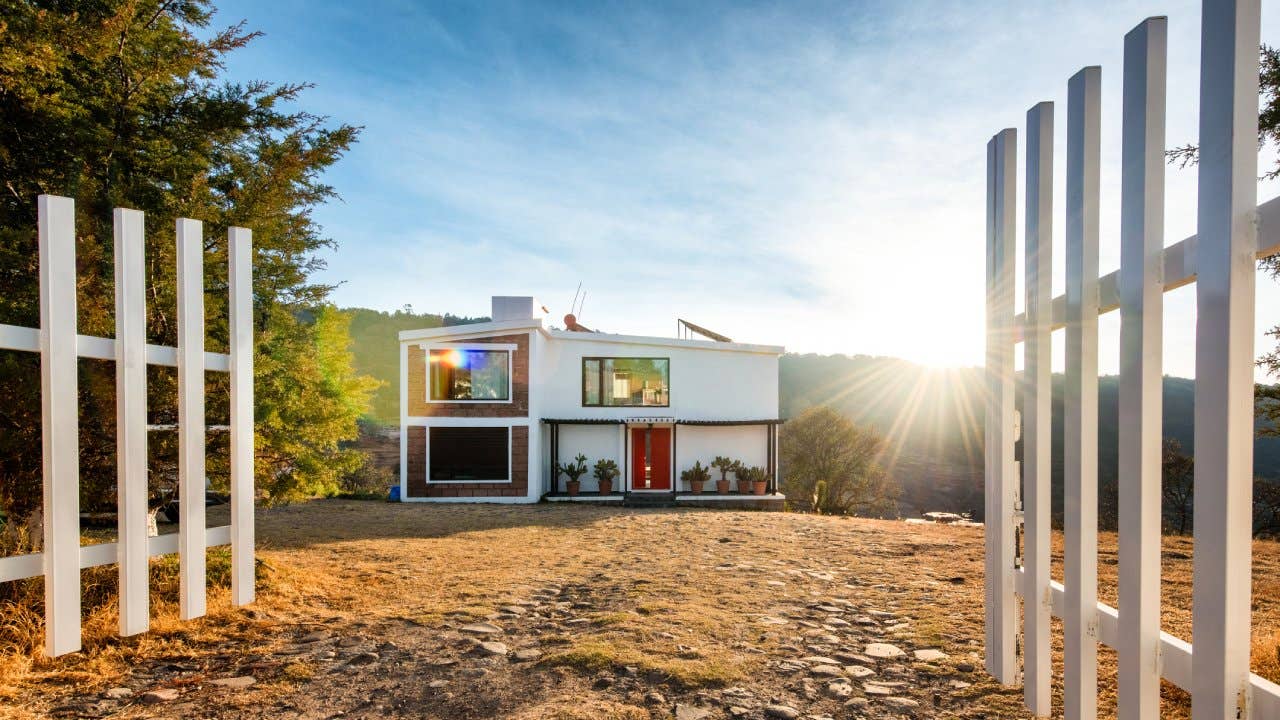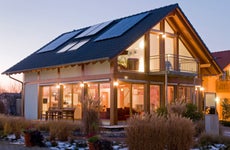Should you buy a home that’s off the grid?

The Bankrate promise
At Bankrate we strive to help you make smarter financial decisions. While we adhere to strict , this post may contain references to products from our partners. Here's an explanation for .
“Going off the grid” generally refers to someone aiming to live in a more natural, eco-friendly way. It doesn’t necessarily mean eschewing electricity and other contemporary comforts altogether, but it usually does mean disconnecting from traditional energy sources in favor of clean ones (think solar, wind, etc.). The idea of living off the grid is to be more mindful of technology usage and reducing your carbon footprint, leading a more self-sufficient/less fossil fuel-dependent life.
Over half the realtors surveyed in the National Association of Realtors’ (NAR) “2022 REALTORS and Sustainability Report” found that house-hunters are interested in sustainability. Which raises the question: Should you buy a home that’s off the grid? Or convert a home once you do buy it? Here’s what you need to consider.
Different ways to live off the grid
The first thing to know: There’s no one definition of “off the grid.” There are different levels of off-grid living, from full self-sustainability to semi-independence from public utilities to actively using alternative energy sources.
Roughing it
This type of living off the grid means you’re fully self sufficient and don’t rely on outside sources for your energy, water or sewage removal. It tends to be the least expensive version, but it does require you to do most of the work yourself.
Roughing it will most likely require you to make some significant lifestyle changes, such as making modifications to an existing home or build a new house on land that doesn’t have any connections to public electric or septic systems.
In order to go off the grid this way, you’ll need to commit to an energy source and find a way to connect it to your home or devices (if it’s not there already). Most commonly, this would be using solar panels, installing a solar shingled-roof , or using solar-powered generators. Plus, you’ll need to find some way to collect water — such as using a nearby river or rainwater catchment — for drinking and sanitary needs.
Since those who are “roughing it” are aiming to rely on themselves, most also build a small homestead — aka a farm, growing as much of their own food as possible.
Partial
Being partially off the grid means living half-off and half-on — a good compromise for those who still want to live in a more self-sufficient way, but aren’t interested in supplying all of their own needs.
Living partially on the grid can vary quite a bit. For instance, you can have solar panels and a generator supplying all of your electricity, but still use your city or county’s sewage infrastructure. Or, you can use a pump or a well for water but still hook your home up to the municipal supply, should the well run dry.
Some who live partially off the grid may also choose to grow much of their own food, but may not commit to maintaining a full, self-sufficient homestead.
Modern
Living in a modern way of the grid is the least severe version. As in, you’re still mostly using conventional grid technology, but have elements that allow you some alternatives and a minimal degree of self-sufficiency.
While this can cost the most in terms of utilities compared to “roughing it” and partial living, it may be more affordable than completely relying on outside sources of electricity, water and sewage. Some may choose to have a garden or raise chickens for their sources of food.
Like partial off-grid living, this degree of self-sufficiency is flexible depending on your needs and preferences. For instance, you rely partially on solar panels for electricity, using your local municipality’s electrical grid just at night. Or you have a heat pump for heating and cooling your home, but do have a furnace as a backup for low-temperature days. Or you have a septic tank for your bathroom, but maintain a sewage line too.
How to have a home off the grid
If you want to get off the grid, here are some guidelines for your house-hunting list, depending on how self-sufficient you want to be.
Choose the right location
Your home’s locale will depend on the degree to which you want to live off the grid. If you’re choosing to live partially off-grid, you may be able to get away with living in a suburban area or more of an ex-urban area. However, if you want to completely rough it, then you’ll need to plan for finding a real rural patch of land and building your own house, or finding one — perhaps a converted barn — in a bucolic area.
Check for alternative sources of energy
There are several sources of alternative energy you can harness, depending on location and how much you want to rough it:
- Solar panels. One of the most popular options due to ease of use, you can purchase an inverter and batteries to store excess electricity. It may come with a higher cost initially, especially if you choose to provide electricity for a large home.
- Micro-hydro-electricity. Though not as popular, you can use a source of running water like a stream to generate electricity. However, it may be harder to set up and not always be feasible if you’re not close enough to a dependable water source.
- Wind turbines. This alternative is generally not as popular as you’ll need the space and the know-how to maintain this type of machinery. You may be able to tap into others’ wind turbines, but doing so can cost more.
- Gas or diesel generators. Another popular method, you can use generators to power the whole house, as a backup source, or minimal appliances if you rough it. Keep in mind you’ll need to purchase gas or diesel, so you’re not totally self-sufficient — and that these are technically fossil fuels.
Find ways to harvest water
If you want your own source of water, you may have to drill a well and find a way to get the running water to your house. Or, you can set up large rainwater catchments, or take advantage of a stream nearby.
Don’t forget to consider the type of septic system you want, or whether you’re fine with using an outhouse.
What are the disadvantages of going off the grid?
Though going off the grid may be a good lifestyle choice, there are several downsides, including:
- Cost. While you could save money over the long run, the upfront costs of setting up an alternative electricity, water, and sewer source can be high. Depending on how much you spend, it could take several years or more to recoup the costs.
- Inconvenience. Going off-grid requires some lifestyle changes. You need to be prepared for physical labor, possibly doing tasks such as getting water and growing your own food.
- Potential health risks. If you live far away from amenities like doctors and hospitals, you may have a harder time getting medical care, especially during emergencies.
- Illegality. In many parts of the U.S., living off-grid is technically illegal. If you don’t obey local building codes or zoning ordinances, you could be liable for fines or charges of endangering your family or others.
The final word on buying a home off the grid
While a fully self-sustainable life may be impractical, partially living off the grid can certainly be done, and homes set up for it are available in increasing numbers. Try to find a realtor or real estate agent who specializes in green or eco-friendly homes. They can steer you to the right regions, help you navigate the legalities of those markets and figure out just how grid-free you want to be.
Related Articles



